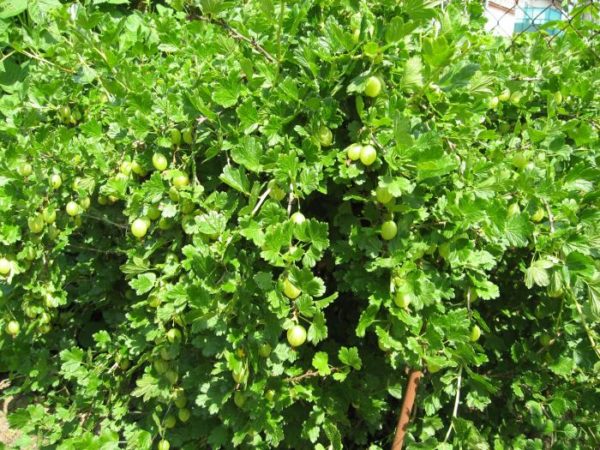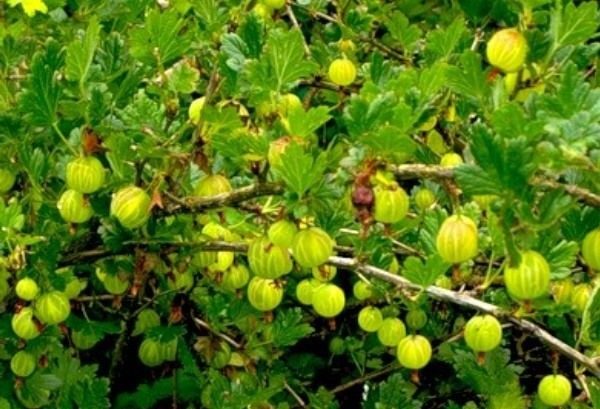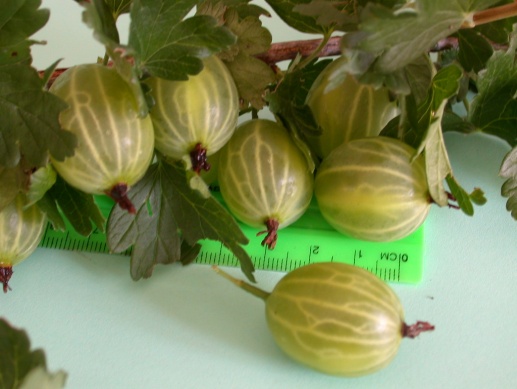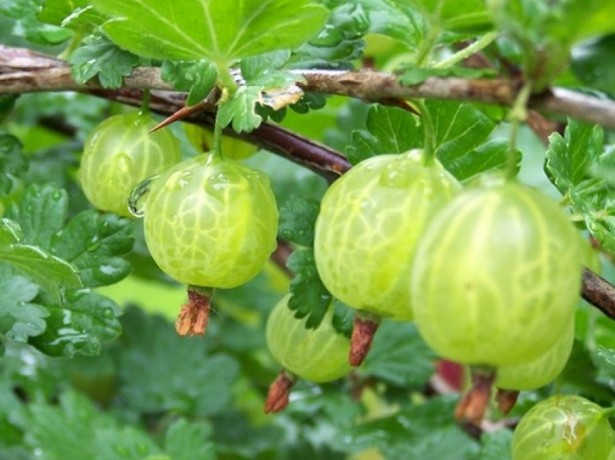Among the many varieties of gooseberry Malachite is very popular. The name of the variety fully characterizes itself, thanks to the emerald colored berry, with a waxy coating that gives it a special shade.
Table of contents
Description and characteristics of the gooseberry Malachite
Let's start with a description of gooseberry Malachite. The variety was obtained in 1959 at the All-Russian Research Institute of Horticulture them.I.V. Michurin by crossing Black Negus and Phenicia. The author of the idea was K.Sergeeva.
The variety has a medium early ripening period, has a long fruiting period. Large bushes are characterized by strong growth with a large number of interlocking shoots. Standard indicators of height of bushes reach one meter. Differs rare spikes, which are located along the entire length of the shoot and allow you to freely harvest.
Lestuary with a smooth surface of greenish color, dull, lowered. Leaf plate concave, five lobed, pointed tip.
Large round berries have a green color with the presence of a light wax coating. The average weight of the fetus is 6 grams. It is characterized by a large number of seeds, thin skin with a strong venation. Ripe with juicy tender pulp fruits have a sour taste, with a slight sweet note and have a rich berry aroma.
Gooseberry belongs to the group of samoplodnyh varieties. It gives berries two years after planting. After three years, enters the active stage of fruiting. Flowering occurs in May. Berries begin to ripen in early July.
The advantages and disadvantages of the variety
The main benefits include:
- high and stable yield, with the right care from one bush you can collect about 4 kg of berries;
- excellent taste characteristics of ripened berries;
- fruits of universal purpose;
- characterized by good winter hardiness;
- not exposed to powdery mildew;
- ripe fruits are not showered from the branches, acquiring a beautiful amber color and tangible sweetness;
- successfully transported over long distances, while not losing its presentation.
Disadvantages include:
- moderate resistance to such disease as anthracosis;
- Yield below average when improperly grown.

Feeding rules
Malachite requires appropriate batteries. In the spring before flowering needs nitrogen, which can be added in dry and in liquid form. A positive result gives fertilizing with liquid organic fertilizers using fermented mullein, chicken manure.During the formation of buds need to feed phosphorus.
By autumn, berry bushes suck almost all nutrients out of the soil. Therefore, it is high time to introduce phosphoric and potash supplements that promote the ripening of wood, strengthen the plant, and increase frost resistance.
The region of natural plant growth
The variety is specially bred for regions with such climatic features as a long winter and not a hot summer.. For such conditions, winter-hardy shrubs that adapt well to strong winds and changeable weather are necessary, and Malachite gooseberry belongs to them. Suitable for cultivation in central Russia and Moscow region.
Features planting gooseberry seedlings
When growing shrubs, it is necessary to take into account all the needs of the plant and create ideal conditions for the normal growth of the shrub and achieve maximum fruit yield.
The plant can be planted both in spring and in autumn, but the favorable planting period is autumn, because the roots of the seedlings have time to take root and form new roots, and also to harden before the onset of winter cold. The suitable time is the end of September and October.
When choosing a site for planting, it is better to give preference to a sunny and light, protected from winds and drafts, a site with slightly acid and neutral mail. The ideal solution would be to plant the plant in loose, loamy or clayey soil.
The hole must be dug a couple of weeks before planting. The size should be 50 to 50, and the depth - 60 cm. Equip the hole with manure or humus, complex mineral fertilizers and fertile soil, then pour.
For planting, it is necessary to use only one-year or two-year-old seedlings that are distinguished by health, a well-developed system of roots and an aerial part, since such a plant will come into fruition earlier. Seedlings before planting carefully inspect and remove damaged and dry parts of the roots and branches.
Planting material placed in the recess, gently straightening the roots. Fill with earth and properly compact, preventing the formation of unnecessary voids. The surface of the filled hole is well watered.
In the end, prune shoots from above, leaving 5-6 buds above the soil surface. Also carry out soil mulching, which will help maintain the necessary balance of moisture and nutrients. And if the landing was made in the fall, it will protect the ground from freezing.

Care rules
The process of growing gooseberries has its own characteristics that should be paid attention to. One of the highlights is the care of the plant. Important activities are pruning, feeding, watering, loosening, fighting diseases and pests.
- Crop. The procedure is carried out immediately after disembarkation. Shorten all the shoots, leaving about six buds below. In the future, the event is carried out in early spring before the buds begin to swell and late in the fall after the plant has dropped foliage.
In the autumn, it is necessary to cut the shoots that grow low, as well as weak, sick, long and very dark color. It is necessary to cut the tops, when the berries on them are small.In early spring, pruned and frozen shoots over the winter are subject to pruning. Fresh cuts do not forget to handle garden pitch.
- Watering and mulching. To obtain a decent crop, you must constantly maintain an appropriate moisture regime and nutrient balance of the soil. Watering should be carried out during the formation of ovaries, the appearance of young shoots and during the formation and ripening of fruits. Also, to enhance the growth of the roots and the preparation of the plant for the winter you need to perform a watering irrigation. Conduct such watering from late September to mid-October.
Shrubs watered at the root, it is to reduce the incidence of culture. It is not recommended to perform watering by sprinkling and using cold water. In order to prevent the evaporation of excess moisture, the soil around the bush should be mulched using peat or compost.
To enrich the roots of plants with oxygen should loosen the top layer of soil. It will also help to eradicate weeds and prevent the occurrence of a dense crust on the surface of the earth.
- Top dressing
Malachite is an unpretentious variety, but like all plants it requires the necessary fertilizer. Feeding is administered twice a year, starting from a two-year term. The first is carried out in the spring after flowering to increase yields, and the second - after picking berries. To this end, fertilizers are added using organic and mineral products. For excellent results, you can use liquid root and foliar supplements.
If you follow all the rules of basic care, you can be absolutely sure in obtaining a high-quality and rich harvest.

Pest and disease control
Diseases and pests can worsen the crop and cause gooseberry to die. Shrubs plants are prone to many diseases and attacks of pests, but the main thing in time to determine the first signs of the disease and carry out appropriate measures to quickly help the plant to cope with them. In the initial stages of the development of diseases, it will be sufficient to use only folk methods, without resorting to chemical preparations.
Moths, aphids, sawflies are pests that can be picked by berry bushes.. Proper care and compliance with sanitary standards will reduce the likelihood of the emergence and development of parasites, but if an invasion has occurred, then it must be treated with solutions specially designed for this purpose.
For such a common disease like powdery mildew, the variety has resistance, but other diseases, such as anthracosis, septoria, rust, may well happen, so you should include preventive measures in caring for the plant:
- strictly follow the principles of agrotechnology for growing plants;
- do not allow the bushes to thicken and in due time to pruning;
- clean the fallen leaves, destroying them by burning;
- dig the soil under the bush;
- plant near the gooseberry plants that can scare off pests;
- in the spring, pour over the bushes, using boiling water, which will help to destroy the fungi that formed spores;
- constantly nourish to strengthen the immunity of the culture;
- spray the bushes with appropriate preparations.
If diseases and pests overtook gooseberry bushes, you need to urgently cut off the branches affected by fungus and insects and burn them. Create a useful microflora by diluting any organic fertilizer with water.Then strain and apply the resulting mass spraying. It is also possible to treat the whole plant and soil with a solution of iron sulphate or other effective means.
Due to the fresh tart taste of the berries, the rich composition of valuable substances, vitamins and minerals, gardeners prefer this particular gooseberry variety, so the variety does not lose its relevance and is not inferior to new hybrids.
